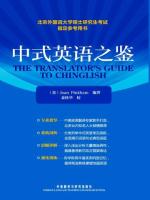有感
Reflections on The Translator's Guide to Chinglish
The Translator's Guide to Chinglish, authored by Joan Pinkham, is a groundbreaking resource that delves deep into the intricacies of Chinglish—a hybrid language form resulting from the direct translation of Chinese expressions into English. As a translator and language enthusiast, I found this book to be an invaluable guide that not only illuminates common pitfalls in English writing but also provides practical strategies for producing clear, concise, and natural-sounding English. Through its detailed analysis of Chinglish examples and insightful suggestions for improvement, Pinkham’s work offers profound insights into the art of translation and the importance of cultural sensitivity in cross-linguistic communication.
One of the most striking aspects of The Translator's Guide to Chinglish is Pinkham’s meticulous categorization of Chinglish patterns. She identifies three primary types: "unnecessary words," "redundant expressions," and "inappropriate collocations." By breaking down these patterns, Pinkham makes it easier for readers to recognize and rectify Chinglish in their own writing. For instance, she points out that Chinese often employs more words to convey meaning compared to English, leading to verbose and convoluted sentences. English, on the other hand, values conciseness and directness. This cultural difference in linguistic preferences highlights the need for translators to adapt their writing style to suit the target language's norms.
Pinkham’s emphasis on the importance of context in translation is another key takeaway from the book. She argues that translating words in isolation without considering their broader context can lead to misunderstandings and awkward phrasing. For example, the Chinese phrase “改革开放” is often translated as “reform and opening up,” but this literal translation fails to capture the full significance of the term in the Chinese context. A more nuanced translation might be “economic reform and opening to the outside world,” which better conveys the intended meaning. This example underscores the need for translators to have a deep understanding of both the source and target languages, as well as the cultural and historical contexts in which the language is used.
In addition to its practical advice on translation, The Translator's Guide to Chinglish also offers valuable insights into the cultural differences between Chinese and English-speaking societies. Pinkham notes that Chinese culture places a greater emphasis on collectivism and harmony, while English-speaking cultures tend to prioritize individualism and directness. These cultural differences are reflected in language use, with Chinese often employing more indirect and polite expressions, while English favors straightforward and assertive communication. Understanding these cultural nuances is essential for effective translation, as it allows translators to adapt their writing style to suit the cultural expectations of the target audience.
Another strength of Pinkham’s book is its use of real-world examples to illustrate key concepts. Throughout the text, she provides numerous examples of Chinglish sentences and offers suggestions for improvement. These examples are drawn from a wide range of sources, including government documents, news articles, and business communications, making the book relevant and applicable to a variety of translation contexts. By analyzing these examples, readers can gain a better understanding of the common pitfalls of Chinglish and learn how to avoid them in their own writing.
The book also offers practical strategies for improving English writing skills, such as using active voice, avoiding passive constructions, and choosing precise and concrete words. Pinkham provides detailed explanations of these strategies and offers numerous examples to illustrate their application. For instance, she recommends replacing passive voice with active voice to make sentences more engaging and easier to understand. By following these tips, readers can enhance the clarity and effectiveness of their English writing, whether they are translating from Chinese or writing original English texts.
Furthermore, The Translator's Guide to Chinglish highlights the importance of continuous learning and practice in the field of translation. Pinkham encourages readers to develop a critical eye for Chinglish and to constantly seek opportunities to improve their writing skills. She suggests reading widely in English, studying grammar and vocabulary, and seeking feedback from native speakers or experienced translators. By adopting a growth mindset and committing to lifelong learning, translators can stay updated with the latest trends and best practices in the field and enhance their professional competence.
In conclusion, The Translator's Guide to Chinglish is a must-read for anyone involved in Chinese-English translation or interested in improving their English writing skills. Through its comprehensive analysis of Chinglish patterns, practical advice on translation, and insightful exploration of cultural differences, the book offers a wealth of knowledge and guidance that is both relevant and valuable. Whether you are a beginner translator or an experienced professional, this book will undoubtedly enhance your understanding of the translation process and help you produce high-quality English texts. Pinkham’s work serves as a constant reminder of the importance of cultural sensitivity, context awareness, and linguistic proficiency in the field of translation, and it will continue to be a valuable resource for generations of translators to come.



 京公网安备 11010802032529号
京公网安备 11010802032529号